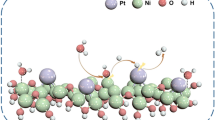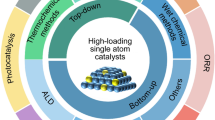Abstract
The promoting effect of sulfur sources is an intriguing but poorly understood phenomenon. Herein, we studied the treatment of PdCu bimetallic nanoparticles (NPs) with different amounts of sulfur powder. Low-level sulfidation led to the generation of a Pd30Cu10S9 NP catalyst consisting of surface enriched Pd NPs, electron deficient Pd and Cu, as well as zero valence sulfur. The Pd30Cu10S9 NP catalyst showed pronouncedly enhanced activity and selectivity in the semihydrogenation of alkynes. Our study revealed for the first time a possible cause for the promoting effect of sulfur at the atomic level, suggesting a new strategy in catalyst design.

Similar content being viewed by others
References
Rezaeian, I.; Zahedi, P.; Rezaeian, A. Rubber adhesion to different substrates and its importance in industrial applications: A review. J. Adhes. Sci. Technol. 2012, 26, 721–744.
Klingender, R. C. Handbook of Specialty Elastomers; CRC Press: Boca Raton, FL, 2008.
Bhowmick, A. K. Current Topics in Elastomers Research; CRC Press: Boca Raton, FL, 2008.
Datta, R. N.; Huntink, N. M.; Datta, S.; Talma, A. G. Rubber vulcanizates degradation and stabilization. Rubber Chem. Technol. 2007, 80, 436–480.
Drost, R. M.; Rosar, V.; Marta, S. D.; Lutz, M.; Demitri, N.; Milani, B.; de Bruin, B.; Elsevier, C. J. Pd-catalyzed Z-selective semihydrogenation of alkynes: Determining the type of active species. ChemCatChem. 2015, 7, 2095–2107.
Dovell, F. S.; Greenfield, H. Platinum metal sulfides as heterogeneous hydrogenation catalysts. J. Am. Chem. Soc. 1965, 87, 2767–2768.
Lindlar, H. Ein neuer Katalysator für selektive Hydrierungen. Helv. Chim. Acta 1952, 35, 446–450.
McKenna, F. M.; Anderson, J. A. Selectivity enhancement in acetylene hydrogenation over diphenyl sulphide-modified Pd/TiO2 catalysts. J. Catal. 2011, 281, 231–240.
Mori, A.; Mizusaki, T.; Miyakawa, Y.; Ohashi, E.; Haga, T.; Maegawa, T.; Monguchi, Y.; Sajiki, H. Chemoselective hydrogenation method catalyzed by Pd/C using diphenylsulfide as a reasonable catalyst poison. Tetrahedron 2006, 62, 11925–11932.
Rodríguez, J. C.; Santamaría, J.; Monzón, A. Hydrogenation of 1,3-butadiene on Pd/SiO2 in the presence of H2S deactivation and reactivation of the catalyst. Appl. Catal. A 1997, 165, 147–157.
Hutchings, G. J.; King, F.; Okoye, I. P.; Padley, M. B.; Rochester, C. H. Selectivity enhancement in the hydrogenation of α,β-unsaturated aldehydes and ketones using thiophene-modified catalysts. J. Catal. 1994, 148, 453–463.
Bartholomew, C. H.; Bowman, R. M. Sulfur poisoning of cobalt and iron fischer-tropsch catalysts. Appl. Catal. 1985, 15, 59–67.
McCue, A. J.; Anderson, J. A. Sulfur as a catalyst promoter or selectivity modifier in heterogeneous catalysis. Catal. Sci. Technol. 2014, 4, 272–294.
Wang, D.-S.; Xie, T.; Li, Y.-D. Nanocrystals: Solution-based synthesis and applications as nanocatalysts. Nano Res. 2009, 2, 30–46.
Astruc, D. Nanoparticles and Catalysis; Wiley-VCH Verlag GmbH & Co. KGaA: Weinheim, Germany, 2008.
Wang, Q.; Ostafin, A. E. Encyclopedia of Nanoscience and Nanotechnology; American Scientific Publishers: Stevenson Ranch, CA, 2004; Vol. 5.
Wang, X.-L.; Liu, X.; Zhu, D.-W.; Swihart, M. T. Controllable conversion of plasmonic Cu2−xS nanoparticles to Au2S by cation exchange and electron beam induced transformation of Cu2−xS–Au2S core/shell nanostructures. Nanoscale 2014, 6, 8852–8857.
Wang, D.-S.; Li, X.-Y.; Li, H.; Li, L.-S.; Hong, X.; Peng, Q.; Li, Y.-D. Semiconductor–noble metal hybrid nanomaterials with controlled structures. J. Mater. Chem. A 2013, 1, 1587–1590.
Yang, J.; Ying, J.-Y. Room-temperature synthesis of nanocrystalline Ag2S and its nanocomposites with gold. Chem. Commun. 2009, 3187–3189.
Wang, D.-S.; Xie, T.; Peng, Q.; Li, Y.-D. Ag, Ag2S, and Ag2Se nanocrystals: Synthesis, assembly, and construction of mesoporous structures. J. Am. Chem. Soc. 2008, 130, 4016–4022.
Habas, S. E.; Yang, P.-D.; Mokari, T. Selective growth of metal and binary metal tips on CdS nanorods. J. Am. Chem. Soc. 2008, 130, 3294–3295.
Teranishi, T.; Saruyama, M.; Nakaya, M.; Kanehara, M. Anisotropically phase-segregated Pd–Co–Pd sulfide nanoparticles formed by fusing two Co–Pd sulfide nanoparticles. Angew. Chem., Int. Ed. 2007, 46, 1713–1715.
Teranishi, T.; Inoue, Y.; Nakaya, M.; Oumi, Y.; Sano, T. Nanoacorns: Anisotropically phase-segregated CoPd sulfide nanoparticles. J. Am. Chem. Soc. 2004, 126, 9914–9915.
Wang, Y.; Chen, Z.; Shen, R.-A.; Cao, X.; Chen, Y.-G.; Chen, C.; Wang, D.-S.; Peng, Q.; Li, Y.-D. Pd-dispersed CuS hetero-nanoplates for selective hydrogenation of phenylacetylene. Nano Res. 2016, 9, 1209–1219.
Cui, J. B.; Li, Y. J.; Liu, L.; Chen, L.; Xu, J.; Ma, J. W.; Fang, G.; Zhu, E. B.; Wu, H.; Zhao, L. X. et al. Near-infrared plasmonic-enhanced solar energy harvest for highly efficient photocatalytic reactions. Nano Lett. 2015, 15, 6295–6301.
Sang, W.; Zheng, T. T.; Wang, Y. C.; Li, X.; Zhao, X.; Zeng, J.; Hou, J.-G. One-step synthesis of hybrid nanocrystals with rational tuning of the morphology. Nano Lett. 2014, 14, 6666–6671.
Jia, W.; Liu, Y.-X.; Hu, P.-F.; Yu, R.; Wang, Y.; Ma, L.; Wang, D.-S.; Li, Y.-D. Ultrathin CuO nanorods: Controllable synthesis and superior catalytic properties in styrene epoxidation. Chem. Commun. 2015, 51, 8817–8820.
Mao, J.-J.; Liu, Y.-X.; Chen, Z.; Wang, D.-S.; Li, Y.-D. Bimetallic Pd–Cu nanocrystals and their tunable catalytic properties. Chem. Commun. 2014, 50, 4588–4591.
Tauson, V. L.; Goettlicher, J.; Sapozhnikov, A. N.; Mangold, S.; Lustenberg, E. E. Sulphur speciation in lazurite-type minerals (Na, Ca)8[Al6Si6O24](SO4, S)2 and their annealing products: A comparative XPS and XAS study. Eur. J. Mineral. 2012, 24, 133–152.
Shemesh, Y.; Macdonald, J. E.; Menagen, G.; Banin, U. Synthesis and photocatalytic properties of a family of CdSPdX hybrid nanoparticles. Angew. Chem., Int. Ed. 2011, 50, 1185–1189.
Mott, D.; Yin, J.; Engelhard, M.; Loukrakpam, R.; Chang, P.; Miller, G.; Bae, I. T.; Das, N. C.; Wang, C.-M.; Luo, J. et al. From ultrafine thiolate-capped copper nanoclusters toward copper sulfide nanodiscs: A thermally activated evolution route. Chem. Mater. 2010, 22, 261–271.
Han, D. S.; Batchelor, B.; Abdel-Wahab, A. XPS analysis of sorption of selenium(IV) and selenium(VI) to mackinawite (FeS). Environ. Prog. Sustain. Energy 2013, 32, 84–93.
Sako, E. O.; Kondoh, H.; Nakai, I.; Nambu, A.; Nakamura, T.; Ohta, T. Reactive adsorption of thiophene on Au(111) from solution. Chem. Phys. Lett. 2005, 413, 267–271.
Hagen, J. Industrial Catalysis, 2nd ed.; Wiley-VCH: Weinheim, 2006.
Siau, W. Y.; Zhang, Y.; Zhao, Y. Stereoselective synthesis of Z-Alkenes. In Stereoselective Alkene Synthesis. Topics in Current Chemistry; Wang, J., Ed.; Springer: Berlin, Heidelberg, 2012; Vol. 327, pp 33–58.
de Vries, J. G.; Elsevier, C. J. The Handbook of Homogeneous Hydrogenation; Wiley-VCH: Weinheim, 2007; Vol. 1.
Yan, M.; Jin, T.-N.; Ishikawa, Y.; Minato, T.; Fujita, T.; Chen, L.-Y.; Bao, M.; Asao, N.; Chen, M.-W.; Yamamoto, Y. Nanoporous gold catalyst for highly selective semihydrogenation of alkynes: Remarkable effect of amine additives. J. Am. Chem. Soc. 2012, 134, 17536–17542.
Acknowledgements
This work is supported by the National Natural Science Foundation to China (Nos. 21625104 and 21521091, W. H.; No. 81703418, H. F. G.)
Author information
Authors and Affiliations
Corresponding authors
Electronic supplementary material
Rights and permissions
About this article
Cite this article
Wu, C., Chen, Y., Shen, R. et al. The promoting effect of low-level sulfidation in PdCuS nanoparticles catalyzed alkyne semihydrogenation. Nano Res. 11, 4883–4889 (2018). https://doi.org/10.1007/s12274-018-2077-x
Received:
Revised:
Accepted:
Published:
Issue Date:
DOI: https://doi.org/10.1007/s12274-018-2077-x




